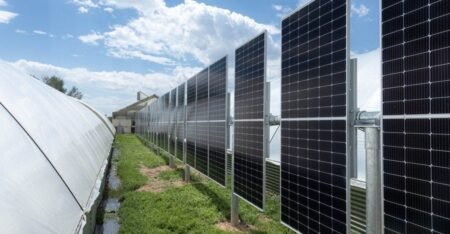Introduction to Perovskite Solar Cells
Perovskite solar cells represent a groundbreaking advancement in the field of photovoltaics. Named after the naturally occurring mineral perovskite, these cells utilize a specific structure of materials with the same crystalline architecture. Perovskite materials exhibit superior light absorption and charge-carrier properties, which make them particularly effective for converting sunlight into electricity. The basic composition of perovskite solar cells typically involves a perovskite-structured compound, most commonly a hybrid organic-inorganic lead or tin halide-based material, sandwiched between two electrodes.
The distinct advantage of perovskite materials lies in their tunable bandgap, which allows for optimization to absorb different portions of the solar spectrum. This flexibility provides a significant edge over traditional silicon-based solar cells, which have a fixed bandgap and thus limited optimization potential. Additionally, perovskite solar cells are known for their high absorption coefficients, enabling the creation of thinner and lighter modules compared to their silicon counterparts.
The unique properties of perovskite solar cells have attracted considerable attention within the research community. They promise higher efficiencies and lower production costs, making them an appealing option for enhancing the performance of solar PV technology. The potential efficiency gains stem from their ability to achieve power conversion efficiencies exceeding 25%, a figure that was once thought unattainable for a new technology within a short development timeline.
Historically, perovskite solar cells have seen rapid progress since their inception. The journey began in 2009 when the first perovskite cells were introduced with an efficiency of merely 3.8%. However, through various innovations and refinements, their efficiency has skyrocketed within just over a decade. Key milestones include the transition from liquid electrolytes to solid-state structures in 2012, significant improvements in material stability, and breakthrough advancements in manufacturing techniques.
This meteoric rise in efficiency and stability marks perovskite solar cells as a serious contender in the future energy landscape. As research continues, the potential for further advancements in perovskite technology ensures that their impact on the solar and global energy markets will be substantial and lasting.
Technology and Manufacturing Processes
Perovskite solar cells represent a groundbreaking advancement in energy technology within the realm of photovoltaics. The primary manufacturing techniques used in their production include solution processing, vapor deposition, and roll-to-roll printing. Each technique offers unique benefits and presents specific challenges.
Solution processing is known for its simplicity and cost-effectiveness. It involves dissolving perovskite precursors in a solvent, creating a solution that can then be spin-coated onto a substrate. This method is advantageous for producing high-quality films at lower temperatures, which reduces energy consumption. However, controlling the uniformity and thickness of the film can be challenging, impacting the overall efficiency of the perovskite solar cells.
Vapor deposition, on the other hand, includes methods such as chemical vapor deposition (CVD) or physical vapor deposition (PVD). This technique allows for precise control over the composition and thickness of the perovskite layer, leading to potentially higher efficiency and better material quality. Despite these advantages, vapor deposition processes are generally more complex and expensive, requiring sophisticated equipment and higher operational costs.
Roll-to-roll printing, which enables continuous production, is highly promising for industrial-scale manufacturing. This technique facilitates the scalable and economical production of large-area perovskite solar cells by using flexible substrates. However, implementing roll-to-roll printing successfully requires overcoming hurdles related to the stability of the perovskite material and uniform ink deposition.
One significant challenge in transitioning perovskite solar cell production from the lab scale to industrial scale is ensuring scalability without sacrificing efficiency. Stability is another critical issue; perovskite materials are sensitive to moisture, oxygen, and UV light, all of which can degrade their performance. To address this, advancements in encapsulation technologies have been crucial. These encapsulation techniques involve layering materials that protect the sensitive perovskite film, thereby enhancing its durability.
Material toxicity, particularly due to the presence of lead in many perovskite formulations, also poses environmental and health concerns. Researchers are actively exploring lead-free alternatives and improved recycling methods to mitigate these risks. With continuous innovation and research, the goal is to develop more stable, efficient, and eco-friendly perovskite solar cells, paving the way for their broader adoption and integration into the global energy market.
Comparative Efficiency and Cost Analysis
In the realm of photovoltaics, the efficiency and cost-effectiveness of different technologies are critical metrics. Perovskite solar cells (PSCs) have emerged as a formidable alternative to traditional silicon-based solar cells (Si-PV) due to their remarkable advancements in energy conversion efficiency. Current experimental data suggest that PSCs have achieved conversion efficiencies exceeding 25%, a figure that closely rivals the efficiency benchmarks held by silicon counterparts. The rapid improvements in this domain are attributable to the unique properties of perovskite materials, which include superior light absorption and charge carrier mobility.
On the cost front, perovskite solar cells outperform Si-PV through several efficiencies in the manufacturing process. Traditional silicon cells require high-temperature processing and extensive raw materials, contributing to elevated production costs. In contrast, PSCs utilize simpler manufacturing techniques such as solution-based processing at lower temperatures, which results in significant reductions in energy and material expenditures. The potential for scaling up production while maintaining lower costs offers a compelling economic advantage.
From a lifecycle perspective, the cost analysis of perovskite solar cells also incorporates considerations of long-term durability and material stability. While early generations of PSCs faced challenges related to degradation under environmental stress, recent advancements have yielded more stable compositions, thereby enhancing their commercial viability. Furthermore, ongoing research is focused on optimizing the perovskite compound to extend the operational life of these cells, which could mitigate replacement costs and improve the overall cost structure.
The combination of high efficiency and cost-effective production positions perovskite solar cells as a transformative technology within the solar energy sector. Future advancements in perovskite stability and production methods promise further reductions in cost, magnifying the scalability and adoption potential of PSCs for comprehensive solar energy solutions. This ongoing evolution underscores the critical role of perovskite solar cells in shaping the future landscape of energy technology, paving the way for more sustainable and economically viable solar power generation.
Impact on the Solar and Global Energy Markets
The emergence of perovskite solar cells is poised to significantly impact the solar energy sector and broader global energy markets by offering a cost-effective and highly efficient alternative to traditional silicon-based photovoltaics. These advanced cells are predicted to disrupt current market dynamics through their ability to deliver higher power conversion efficiencies at a lower manufacturing cost. This shift could expedite the transition towards sustainable energy solutions on a global scale.
The potential market adoption rates of perovskite solar cells largely depend on continued advancements in durability and stability. As research progresses and overcomes the initial hurdles, the perovskite technology will become more viable for mainstream applications. This, combined with increased efficiency, lower costs, and flexible form factors, positions perovskite photovoltaics as a formidable competitor in the solar energy market.
Government policies and incentives play a crucial role in fostering the adoption of perovskite solar cells. Supportive policies, such as subsidies, tax incentives, and renewable energy mandates, can accelerate market penetration and encourage widespread deployment. Governments committed to reducing carbon footprints and promoting green energy are likely to implement frameworks that favor the rapid integration of innovative solar technologies.
The environmental impact of widespread deployment of perovskite solar cells is a critical consideration. These cells not only offer a more sustainable manufacturing process compared to conventional silicon cells but also reduce the reliance on finite resources. Their deployment aligns with global renewable energy goals by minimizing the carbon footprint associated with solar power generation.
Future trends indicate a robust growth trajectory for the perovskite solar cell market. The long-term viability of perovskite technology hinges on overcoming technical challenges and achieving commercial scalability. If these milestones are accomplished, perovskite solar cells will undoubtedly contribute significantly to global renewable energy goals, positioning themselves as a cornerstone in the transition towards a sustainable energy future.










